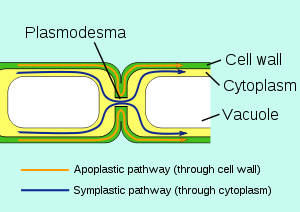
Symplast
Encyclopedia

Plant
Plants are living organisms belonging to the kingdom Plantae. Precise definitions of the kingdom vary, but as the term is used here, plants include familiar organisms such as trees, flowers, herbs, bushes, grasses, vines, ferns, mosses, and green algae. The group is also called green plants or...
is the inner side of the plasma membrane in which water (and low-molecular-weight solutes
Solution
In chemistry, a solution is a homogeneous mixture composed of only one phase. In such a mixture, a solute is dissolved in another substance, known as a solvent. The solvent does the dissolving.- Types of solutions :...
) can freely diffuse
Diffusion
Molecular diffusion, often called simply diffusion, is the thermal motion of all particles at temperatures above absolute zero. The rate of this movement is a function of temperature, viscosity of the fluid and the size of the particles...
.
The plasmodesmata
Plasmodesmata
Plasmodesmata are microscopic channels which traverse the cell walls of plant cells and some algal cells, enabling transport and communication between them. Species that have plasmodesmata include members of the Charophyceae, Charales and Coleochaetales , as well as all embryophytes, better known...
allow the direct flow of small molecules such as sugars, amino acids, and ions between cells. Larger molecules, including transcription factor
Transcription factor
In molecular biology and genetics, a transcription factor is a protein that binds to specific DNA sequences, thereby controlling the flow of genetic information from DNA to mRNA...
s and plant virus
Plant virus
Plant viruses are viruses that affect plants. Like all other viruses, plant viruses are obligate intracellular parasites that do not have the molecular machinery to replicate without a host. Plant viruses are pathogenic to higher plants...
es, can also be transported through with the help of actin
Actin
Actin is a globular, roughly 42-kDa moonlighting protein found in all eukaryotic cells where it may be present at concentrations of over 100 μM. It is also one of the most highly-conserved proteins, differing by no more than 20% in species as diverse as algae and humans...
structures.
This allows direct cytoplasm
Cytoplasm
The cytoplasm is a small gel-like substance residing between the cell membrane holding all the cell's internal sub-structures , except for the nucleus. All the contents of the cells of prokaryote organisms are contained within the cytoplasm...
-to-cytoplasm flow of water and other nutrients along concentration gradients. In particular, it is used in the root systems to bring in nutrients from soil. It moves these solutes from epidermis
Epidermis (botany)
The epidermis is a single-layered group of cells that covers plants' leaves, flowers, roots and stems. It forms a boundary between the plant and the external environment. The epidermis serves several functions, it protects against water loss, regulates gas exchange, secretes metabolic compounds,...
cells through the cortex
Cortex (botany)
In botany, the cortex is the outer layer of the stem or root of a plant, bounded on the outside by the epidermis and on the inside by the endodermis. It is composed mostly of undifferentiated cells, usually large thin-walled parenchyma cells of the ground tissue system. The outer cortical cells...
into the endodermis
Endodermis
The endodermis is the central, innermost layer of cortex in some land plants. It is made of compact living cells surrounded by an outer ring of endodermal cells that are impregnated with hydrophobic substances to restrict apoplastic flow of water to the inside...
and eventually the pericycle
Pericycle
The pericycle is a cylinder of parenchyma cells that lies just inside the endodermis and is the outer most part of the stele of plants.Although it is composed of non-vascular parenchyma cells, it is still considered part of the vascular cylinder because it arises from the procambium as do the...
, where it can be moved into the xylem
Xylem
Xylem is one of the two types of transport tissue in vascular plants. . The word xylem is derived from the Classical Greek word ξυλον , meaning "wood"; the best-known xylem tissue is wood, though it is found throughout the plant...
for long distance transport.
It is contrasted with the apoplast
Apoplast
Within a plant, the apoplast is the free diffusional space outside the plasma membrane. It is interrupted by the Casparian strip in roots, air spaces between plant cells and the cuticula of the plant....
ic flow, which uses cell wall transport.

